The AMD Ryzen Threadripper 3960X and 3970X Review: 24 and 32 Cores on 7nm
by Dr. Ian Cutress, Andrei Frumusanu & Gavin Bonshor on November 25, 2019 9:05 AM ESTCPU Performance: Encoding Tests
With the rise of streaming, vlogs, and video content as a whole, encoding and transcoding tests are becoming ever more important. Not only are more home users and gamers needing to convert video files into something more manageable, for streaming or archival purposes, but the servers that manage the output also manage around data and log files with compression and decompression. Our encoding tasks are focused around these important scenarios, with input from the community for the best implementation of real-world testing.
All of our benchmark results can also be found in our benchmark engine, Bench.
Handbrake 1.1.0: Streaming and Archival Video Transcoding
A popular open source tool, Handbrake is the anything-to-anything video conversion software that a number of people use as a reference point. The danger is always on version numbers and optimization, for example the latest versions of the software can take advantage of AVX-512 and OpenCL to accelerate certain types of transcoding and algorithms. The version we use here is a pure CPU play, with common transcoding variations.
We have split Handbrake up into several tests, using a Logitech C920 1080p60 native webcam recording (essentially a streamer recording), and convert them into two types of streaming formats and one for archival. The output settings used are:
- 720p60 at 6000 kbps constant bit rate, fast setting, high profile
- 1080p60 at 3500 kbps constant bit rate, faster setting, main profile
- 1080p60 HEVC at 3500 kbps variable bit rate, fast setting, main profile
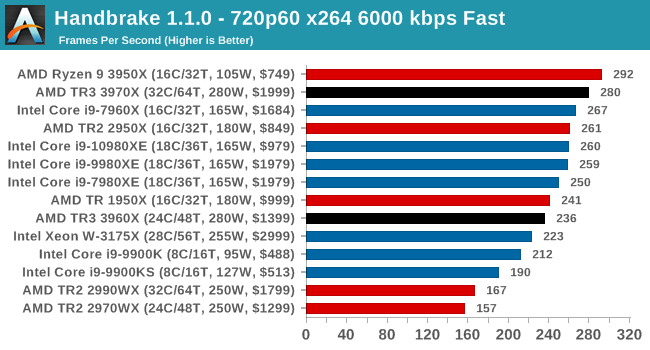
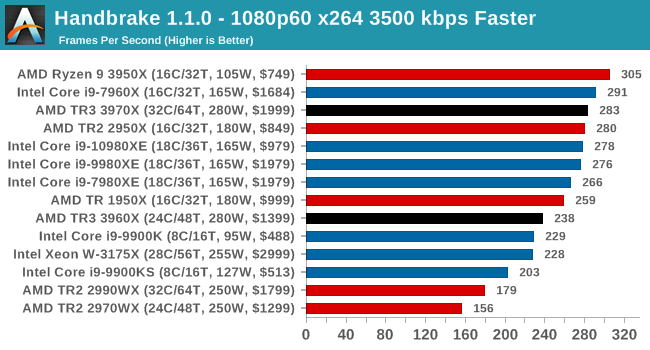

Video encoding is a little varied, based on the variable threaded nature. Certain encoding tests can be more memory sensitive here, or accelerated in different ways, or not scale well with more cores. Either way, TR3 performs a lot better than TR2, but the 3950X seems the best choice.
7-zip v1805: Popular Open-Source Encoding Engine
Out of our compression/decompression tool tests, 7-zip is the most requested and comes with a built-in benchmark. For our test suite, we’ve pulled the latest version of the software and we run the benchmark from the command line, reporting the compression, decompression, and a combined score.
It is noted in this benchmark that the latest multi-die processors have very bi-modal performance between compression and decompression, performing well in one and badly in the other. There are also discussions around how the Windows Scheduler is implementing every thread. As we get more results, it will be interesting to see how this plays out.
Please note, if you plan to share out the Compression graph, please include the Decompression one. Otherwise you’re only presenting half a picture.
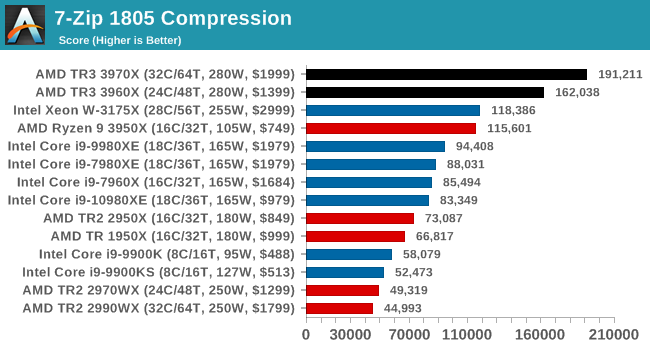
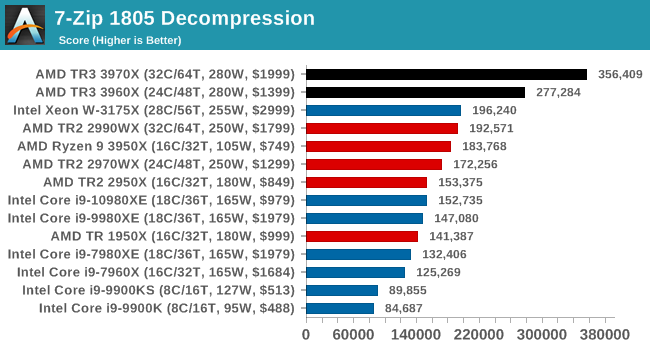
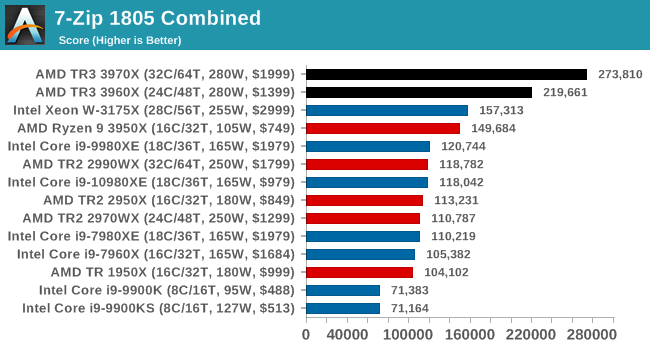
Easily parallel puts the TR3 well ahead of TR2 and Intel.
WinRAR 5.60b3: Archiving Tool
My compression tool of choice is often WinRAR, having been one of the first tools a number of my generation used over two decades ago. The interface has not changed much, although the integration with Windows right click commands is always a plus. It has no in-built test, so we run a compression over a set directory containing over thirty 60-second video files and 2000 small web-based files at a normal compression rate.
WinRAR is variable threaded but also susceptible to caching, so in our test we run it 10 times and take the average of the last five, leaving the test purely for raw CPU compute performance.
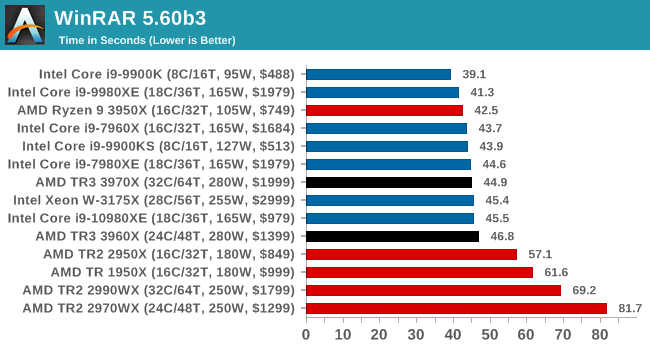
WinRAR is a variably threaded application, and both TR3 processors perform in the same ballpark as anything from Intel. Ideally we should have seen them streak ahead, but we seem to be at a point where CPU frequency or core counts are the limiting factor. At least with Zen 2, there are no issues as there was with Zen 1/Zen+.
AES Encryption: File Security
A number of platforms, particularly mobile devices, are now offering encryption by default with file systems in order to protect the contents. Windows based devices have these options as well, often applied by BitLocker or third-party software. In our AES encryption test, we used the discontinued TrueCrypt for its built-in benchmark, which tests several encryption algorithms directly in memory.
The data we take for this test is the combined AES encrypt/decrypt performance, measured in gigabytes per second. The software does use AES commands for processors that offer hardware selection, however not AVX-512.











245 Comments
View All Comments
RSAUser - Tuesday, November 26, 2019 - link
I've only seen the Mozilla benchmarks on LTT, very strange that they're the only ones showing such a workload. I'd be very interested on how these chips handle e.g. large SQL Server DB's and requests, especially with those huge caches.The Mozilla benchmark had near 2x the performance for the 3970X vs the 10980X and serve the home has the ryzen chip at near 30 compiles an hour for the Linux Kernel vs around 16 for Intel.
I'd actually be really interested in the financial market for this TR due to the floating point performance increase. We'll probably be upgrading our servers next year based on current projections, so this has been a really nice development.
Dolda2000 - Monday, November 25, 2019 - link
Why is it that Intel gains so incredibly much more from AVX512 than AMD gains from AVX2?In the 3DPM2 test, the AMD CPUs gain roughly a factor of two in performance, which is exactly what I'd expect given that AVX2 is twice as wide as standard SSE. The Intel CPUs, on the other hand, gain almost a factor of 9, which is more than twice what I'd expect given that AVX512 as four times as wide as SSE.
What causes this? Does AVX512 have some other kind of tricks up its sleeves? Does opmasking benefit 3DPM2?
AnGe85 - Monday, November 25, 2019 - link
The Intel parts are derived from Xeon dies (LCC 10 cores, and HCC up to 18 cores). As such they have two AVX-512-FMA-Units.Zen/+ shows a +70 % increase in performance, Zen2 and the 9900K(S) about +90 % with AVX2 in 3DPM2.1 and the Xeon-based parts reach up to +700 %. Ian has obviously done a good job or at least used a good lib ;-)
Dolda2000 - Monday, November 25, 2019 - link
But Zen 1/2 also has two 256-bit FMAs per core. And Intel also has two SSE units per core as well, so I don't see how that would explain the ratios.yeeeeman - Monday, November 25, 2019 - link
Intel has 512bit unitsDolda2000 - Monday, November 25, 2019 - link
Exactly, which should make it 2× as fast, not 4.5×.abufrejoval - Tuesday, November 26, 2019 - link
The other element of magic is typically halved operand size=twice the data element throughput.Could be FP16 vs FP32 in that code, which means 32 vector elements per 512 bit register and then again of these registers there could be mulitples under SIMD per instruction and clock.
Xyler94 - Tuesday, November 26, 2019 - link
Servethehome also mentioned in their reviews of Epyc Rome Processors, the same basic Zen2 platform that the new TR CPUs are made on, that most programs aren't optimized for AMD's new AVX2 pipes, so the results are lower than they should be. I don't know if that's still the case, but it may be a reason why it's showing such a disparity between the two.Slash3 - Monday, November 25, 2019 - link
Wow.Just wow.
shaolin95 - Monday, November 25, 2019 - link
Why wont yuo enable IGPU for the 9900k on the Premiere test? It will change the performance dramatically.